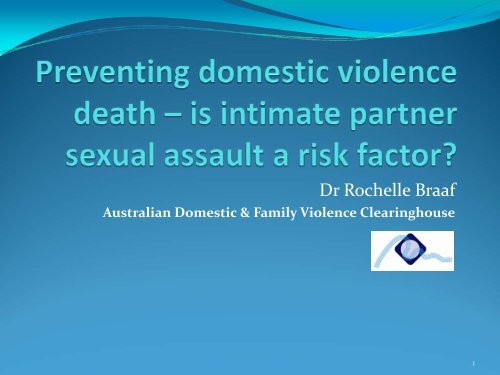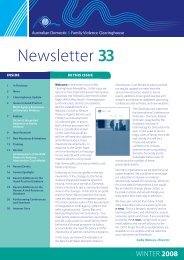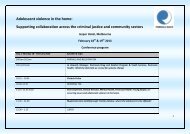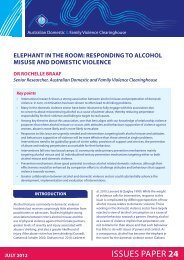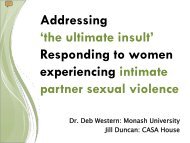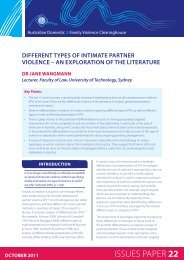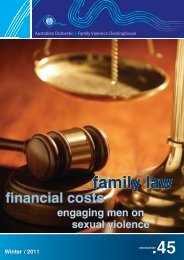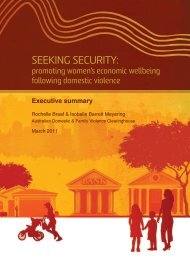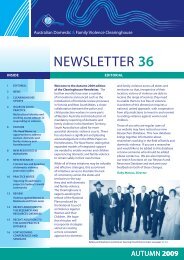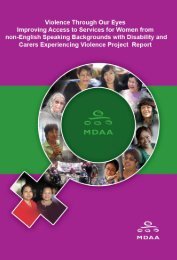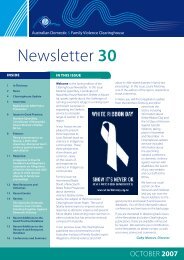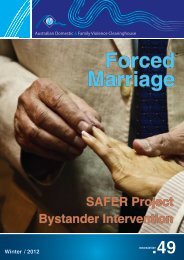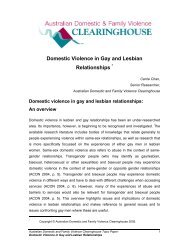Preventing domestic violence death – is intimate partner sexual ...
Preventing domestic violence death – is intimate partner sexual ...
Preventing domestic violence death – is intimate partner sexual ...
You also want an ePaper? Increase the reach of your titles
YUMPU automatically turns print PDFs into web optimized ePapers that Google loves.
Dr Rochelle Braaf<br />
Australian Domestic & Family Violence Clearinghouse<br />
1
Homicide prevention as our goal<br />
• Intimate <strong>partner</strong> homicide <strong>is</strong> a tragic loss of life<br />
• Devastating to those left behind<br />
• Too frequent <strong>–</strong> 80 homicides + 10 offender suicides in<br />
2007/8<br />
• Prevention relies on:<br />
• understanding r<strong>is</strong>k<br />
• understanding men’s behaviours and motivations<br />
2
Intimate <strong>partner</strong> <strong>sexual</strong> <strong>violence</strong> as a r<strong>is</strong>k factor for<br />
homicide<br />
Recogn<strong>is</strong>ed as a r<strong>is</strong>k factor for IP homicide but ‐<br />
‐ under‐reported by women, denied by abusive men and<br />
avoided by workers<br />
Presentation aims:<br />
• consider IPSV in the context of homicide<br />
• consider how to better respond to th<strong>is</strong> r<strong>is</strong>k factor<br />
3
Possible <strong>domestic</strong> <strong>violence</strong> <strong>death</strong>s<br />
(Schafran 2010)<br />
• abuser may kill the (ex)<strong>partner</strong> and/or their children<br />
• abuser may kill third parties<br />
• abuser may kill others and then themselves<br />
• victims may kill themselves<br />
• victim may kill the abuser<br />
4
Evidence linking IPSV and homicide<br />
• Bennice et al 2003 ‐<br />
• McFarlane & Malecha 2005 ‐<br />
• Campbell et al. 2007 <strong>–</strong>10 yr review of <strong>intimate</strong> <strong>partner</strong><br />
homicide<br />
• Dobash et al. 2007 <strong>–</strong> comparative study of DV murderers and<br />
DV abusers<br />
• Adams 2007 <strong>–</strong> study of homicide offenders and victims of<br />
attempted murder and life threatening injury<br />
• Block 2009 <strong>–</strong> comparative study of lethal and non‐lethal<br />
<strong>domestic</strong> <strong>violence</strong> cases<br />
5
IPSV as an exertion of power and a means of<br />
control<br />
• Arousal by violent sex<br />
• Exploiting women when vulnerable<br />
• Demanding sex after <strong>violence</strong><br />
• IPSV continuing or commencing following separation<br />
• Men’s sense of entitlement and rights<br />
• Objectification of women<br />
• Anger about separation and feelings of abandonment<br />
6
Why <strong>is</strong> th<strong>is</strong> a problem<br />
• Women don’t d<strong>is</strong>close<br />
• Men obfuscate<br />
• Workers don’t ask<br />
Other difficulties <strong>–</strong> may be no obvious injury, less likely to be<br />
witnesses, few convictions for <strong>sexual</strong> assault generally<br />
7
What can we do better<br />
• Recogn<strong>is</strong>e the seriousness of IPSV as a r<strong>is</strong>k factor for<br />
lethality<br />
• Identify victims <strong>–</strong> screening (requires training, superv<strong>is</strong>ion<br />
and referral)<br />
• Perpetrator programs to routinely address <strong>sexual</strong> <strong>violence</strong><br />
• Prosecutors to assess r<strong>is</strong>k, craft appropriate orders,<br />
sanctions and sentences<br />
• Probation and parole<br />
• Judges to deny access to children<br />
8


